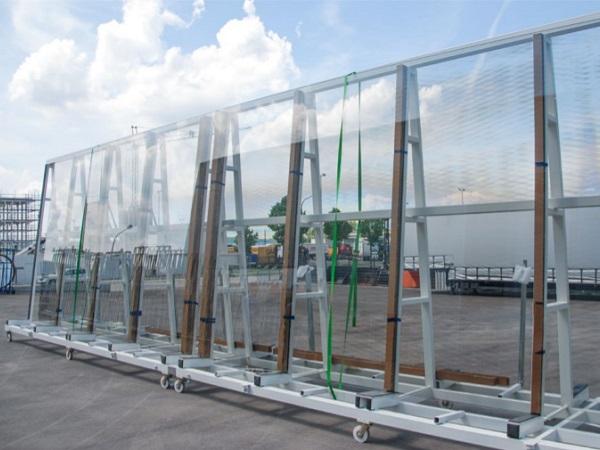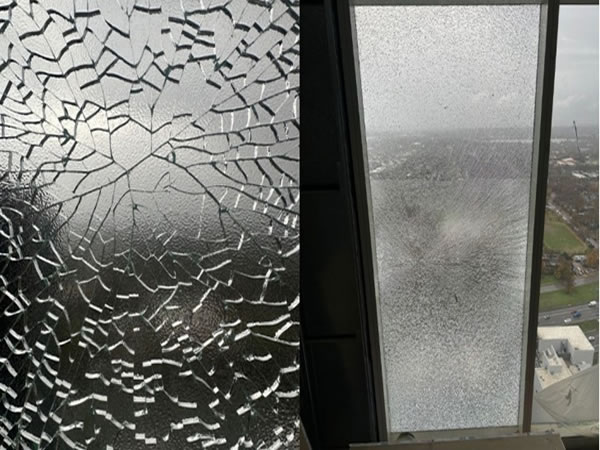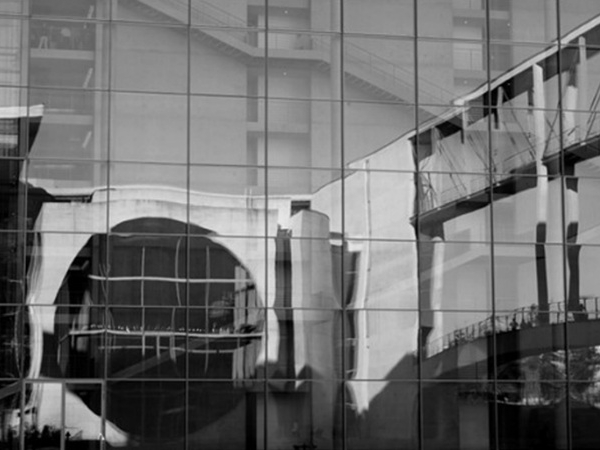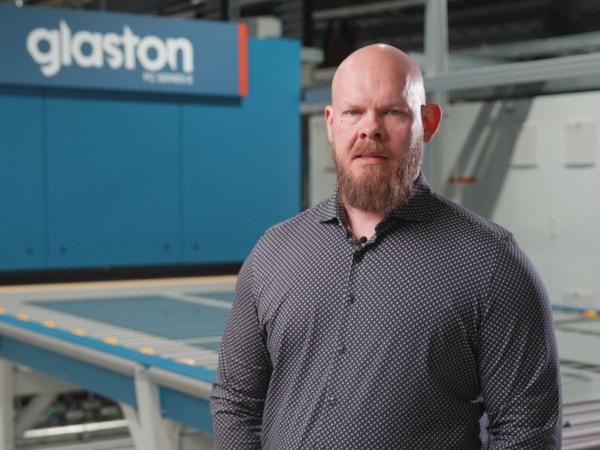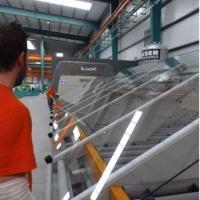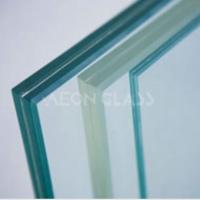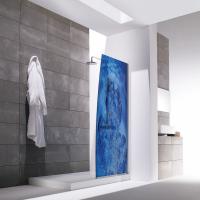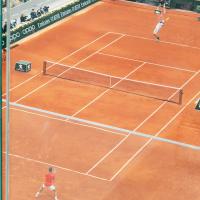The larger a pane is, the more difficult it is to minimize this effect in production. Optimum results can only be achieved with sophisticated machine technology and a great deal of experience.
Anisotropies in tempered glass cannot be completely prevented, even with modern plant technology and know-how. This factsheet explains how these production-related iridescence symptoms occur, how they work and how sedak minimizes this effect.
1 Anisotropies – what are they?
Glass is optically isotropic: Light is transmitted uniformly, the refractive index of light rays is identical in every direction (from Greek isos = equal, tropos = direction, rotation). When the glass is under stress, however, the light refracts twice (glass becomes "an-isotropic"). When a polarized beam of light strikes the glass, it breaks unevenly and diffuses at different speeds in the glass. The light waves no longer exit the glass at the same time. The eye sees this effect as an interference color. Anisotropies are therefore iridescent effects that occur in heat-treated glass due to tempering. They become visible as rainbow-like spots or grey stripes in daylight or LED light and at a certain angle. They do not represent a "justifiable defect" of the glass but are often perceived as optical defects.
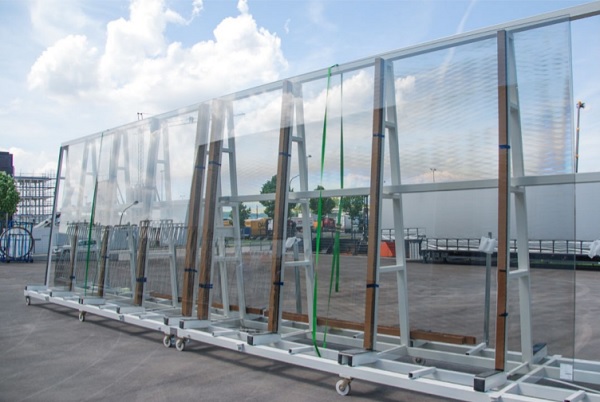
2 Origin
Glass is heated as evenly as possible from all sides during tempering. Completely homogeneous heating - and thus the prevention of anisotropies - is not possible due to production factors. Corners, edges and holes heat up a little faster and also cool down again faster than the glass on the surface. Despite state-of-the-art furnace technology during heating and cooling, stress differences in the glass still cannot be completely ruled out.
Interim conclusion: Since many factors influence the heating and cooling of a pane during tempering, it is not possible for technical production reasons to apply stresses to a pane completely uniformly. Anisotropies in tempered glass can therefore be expected for production reasons.
3 Influencing factors
…on visual perception
Light conditions and perspectives affect the visibility of anisotropies. From a shallow viewing angle, the effect appears larger than when viewed vertically. Anisotropies are more noticeable with polarized glasses. The location also plays a role: The higher the proportion of polarized daylight, the higher the likelihood that anisotropies will become visible. Reflective surfaces such as bodies of water or snow-covered areas increase the perception of anisotropies. Due to their exposed location, high-rise buildings also have a higher risk that anisotropies can be detected. Weather and solar altitude also have their effect: In bright blue skies and low solar altitude, the amount of polarized light is highest, so anisotropies can be detected more quickly.
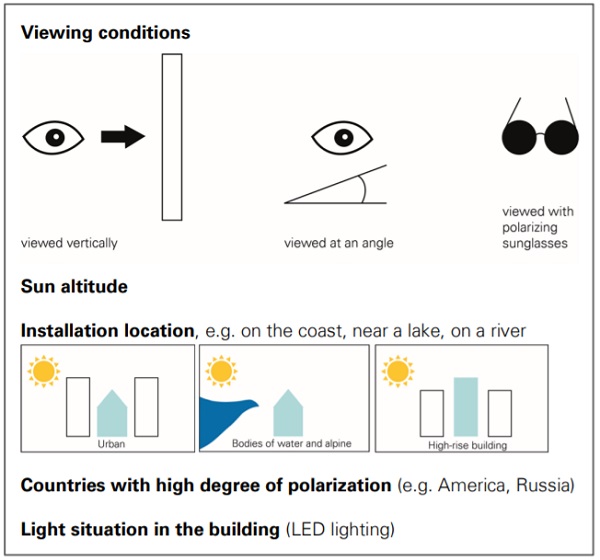
…of the glass
Include pane thickness, glass structure, lamination films and the geometry of the pane. The thicker the pane and the more glass that is installed in a laminate, the greater the iridescent effects will be. Glass with sharp angles, holes or cut-outs, etc., increase the risk of anisotropies, since uniform heating and cooling is more difficult with such geometries than with glass with a rather square dimension. This also means: The larger a glass and the more complex its shape (i.e., the ratio of corners, edges and openings to the surface), the more difficult it becomes to prevent anisotropies.
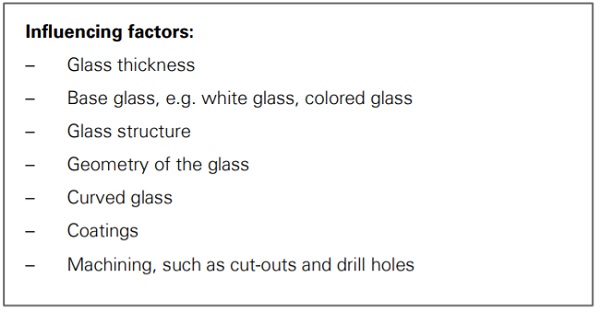
…of production
The importance of the plant controllers is clear from what has been said so far. Especially with oversized panes and glass with extreme aspect rations, tempering requires machines that can be finely controlled as well as a very deft touch. With every meter of glass, the tempering process is more difficult because it has to be taken into consideration that it is not sufficient to provide a constant temperature in the furnace: The pane would not heat up evenly because the heat acts differently on edges and the surface. Particularly extreme aspect rations, e.g., glass fins or beams, require know-how and a great deal of experience in order to achieve optimal appearance and quality. Such components are a high production art, because the individual panes are usually subsequently laminated to a glass composite. To ensure that these glass pieces with aspect ratios up to e.g. 1:84 have as little anisotropy as possible and are also congruent with exact edges, they must not deform during the tempering.
4 Know-how for machine technology
Requirements for fracture properties and mechanical strength do indeed take precedence. However, if the building is, for example, eye-catching due to the size of the glass, the optical quality is given more weight. sedak also uses its almost 15 years of experience in tempering oversized glass when developing new machines. These include tempering furnaces with special heating technology that regulate heat very quickly and very precisely – adapted to the specific requirements of the individual pane. This requirement also applies to the quench (cooling zone). sedak is thus able to reduce anisotropies with state-of-the-art technology and many years of experience in tempering oversized glass or glass with extreme aspect ratios.
5 Quality Controls
The product standards for single-pane safety glass (toughened safety glass) and heat strengthened glass (TVG) stipulate a continuous check of the breakage stresses for each glass type and thickness. A non-destructive method is the use of a scanner. sedak has integrated this into the tempering process. It also detects and records anisotropies. A screen visually displays the stress fields. In this way, the plant controller receives immediate feedback during the tempering process and knows whether they have to intervene.
6 Side note: Why glass must be tempered
As float glass is too fragile for most applications, it is usually tempered. During tempering, the loadbearing capacity increases and the fracture behavior changes. For this purpose, the glass is first heated to over 600 degrees Celsius in the tempering furnace and then cooled again in the quench. Stresses occurs in the glass during cooling, as the glass surface cools faster than the core. The faster the glass is cooled, the higher the stress ratios in the glass.
Heat strengthened glass has a flexural tensile stress of 70N/mm2 (in accordance with EN 572) and a higher thermal shock resistance at 100K than float glass with approx. 40K. If TVG glass breaks, cracks are formed radially around the breakage center. The fragments are still comparatively large. The lower the stress ratios in the glass, the larger the fragments. TVG is used in laminates, for example, for overhead glazing or for glazing that protects against falling material.
Tempered safety glass (ESG) has a flexural strength of 120N/mm² (in accordance with DIN EN 12150) and a thermal shock resistance of 200K. It is therefore highly resilient. In the event of glass breakage, it breaks down into small, blunt-edged pieces. This minimizes the risk of injury. ESG is used, for example, as façade glass in the form of laminated safety glass or as monoglass for glass doors, partition walls and shower walls.
Tempering therefore gives glass the properties that are absolutely necessary for use in construction. On the other hand, it is responsible for anisotropies.
Sources:
https://www.baustoffwissen.de/baustoffe/baustoffknowhow/bauelemente/was-ist-sicherheitsglas-einbruchschutz-verbund-sicherheitsglas-vsg-mehrscheiben-isolierglas-einscheiben-sicherheitsglas-esg-teilvorgespanntes-glas-tvg/
https://www.metallbau-magazin.de/artikel/mb_Vermeiden_von_Anisotropien_3128837.html
Merkblatt FKG 01/2019, Fachverband Konstruktiver Glasbau e.V.
Glas im konstruktiven Ingenieurbau 15, Hochschule München, Tagungsband 2017
Own data / surveys

